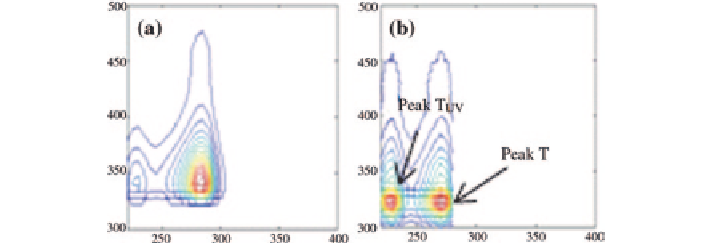Environmental Engineering Reference
In-Depth Information
Fig. 10
Two fluorescent components (
a
,
b
) of lake green algae isolated and resuspensions in
aqueous media (Milli-Q waters) identified using PARAFAC modeling on the respective EEM
data.
Data source
Mostofa KMG et al. (unpublished data)
(
Zhang et al. 2010
; Crist et al.
1981
; Zhou and Wangersky
1985
,
1989
; Simkiss
and Taylor
1989
; Xue and Sigg
1990
; Tessier and Turner
1995
; Sunda and
Huntsman
1998
; Burda et al.
2003
; Koukal et al.
2003
; Mylon et al.
2003
;
Sigfridsson et al.
2004
; Berden-Zrimec et al.
2007
; Lamelas and Slaveykova*
2007
; Hopkinson and Barbeau
2008
; Lamelas et al.
2009
;
Pan et al. 2009
). Various
trace elements detected in phytoplankton are N, P, S, K, Mg, Ca, Sr, Fe, Mn,
Zn, Cu, Co, Cd, Ni, and Mo (Quigg et al.
2003
,
2011
; Finkel et al.
2006
). Study
shows that many elements (Fe, Mn, Zn, Cu, Co, and Mo) are enriched relative to
P by about two to three orders of magnitude under irradiances that are limiting for
growth, and net steady-state uptake of element: P is often elevated under lower
irradiances (Finkel et al.
2006
). Cyanobacteria or phytoplankton cells can form
complexes with or uptake trace metals, either directly or in the presence of humic
acids (Zhou and Wangersky
1985
,
1989
; Xue and Sigg
1990
; Koukal et al.
2003
;
Mylon et al.
2003
; Lamelas and Slaveykova*
2007
; Lamelas et al.
2009
). The
latter can substantially enhance the metal ion uptake. Bacteria, algae (or phyto-
plankton cells) and their exudates are composed of a mosaic of functional groups
(e.g. amino, phosphoryl, sulfhydryl, and carboxylic), and the net charge on the cell
wall is dependent on the pH of the medium (see also chapter
“
Complexation of
description) (Mostofa et al.
2009
; Zhang et al.
2009
,
2010
; Mostofa et al.
2011
;
Filella
2008
). Cyanobacteria or phytoplankton are composed of two fluores-
cent components that can be identified using parallel factor (PARAFAC) analy-
sis on the excitation-emission maxima (EEM) spectra of their resuspensions in
pure water (Fig.
10
) (Mostofa KMG et al. unpublished data). The EEM spectra
of these two fluorescent components identify functional groups bound to trypto-
phan or protein-like components (Fig.
10
; see the chapter
“
Fluorescent Dissolved
Organic Matter in Natural Waters
”
for detailed description) (Mostofa KMG et al.
unpublished data). Furthermore, some trace metal ions (e.g., Th
4
+
and U) form
complexes at the surface of particulate matter with an organic ligand that might be
a nonmetal-specific chelator originating from the cell surface of microorganisms

